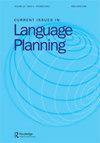匈牙利语在不同的语言政策背景下作为少数民族语言和多数民族语言
IF 1.8
1区 文学
Q2 EDUCATION & EDUCATIONAL RESEARCH
引用次数: 0
摘要
摘要本研究主要关注少数民族匈牙利人在语言多样性方面的情况,即主要在匈牙利语社区的背景下解释各种语言政策问题,而不是在匈牙利的背景下,在匈牙利的背景下,标准语言方言和非标准语言方言的位置、作用和关系起着突出的作用。在大多数情况下,保留匈牙利身份相当于保留非标准语言品种,与此相关的一些语言政策和语言规划问题。这项研究的目的是双重的。一方面,它的目的是提供关于匈牙利语和匈牙利语社区的语言政策情况的最新概览,特别是关于居住在匈牙利邻国的约300万匈牙利本土少数民族的情况。另一方面,本研究从整个匈牙利语社区的角度描述了方言的语言政策作用和相关态度,解决了宏观、中观和微观层面的语言规划可能性。关键词:匈牙利方言非主导语言微观和宏观语言规划匈牙利语少数民族揭秘披露声明作者未报告潜在利益冲突。注1根据最新的人口普查数据,居住在境外的匈牙利人有180万至190万。但是,有许多匈牙利人害怕与其国籍有关的消极后果,因此决定将自己视为多数民族的成员,而不是匈牙利少数民族的成员本单元的摘要分析是根据欧洲委员会网站上公布的公开报告和建议(见https://www.coe.int/en/web/european-charter-regional-or-minority-languages/reports-and-recommendations).3)编写的,尽管通常有正式的法律机制来保护匈牙利语,这种少数民族语言处于从属地位,以及国家语言在整个欧洲民族国家内垂直流动的声望和工具影响了少数民族成员数量的减少(Trudgill, Citation2004)。造成这一消极趋势的因素还包括异族通婚数量的增加,匈牙利人口的移民数量很高(在这方面,见2010年《匈牙利公民法》),同时出生率很低。contributorsIstván JánkIstván Jánk是匈牙利埃格尔Eszterházy Károly天主教大学的高级讲师,也是匈牙利布达佩斯匈牙利研究所语言规划研究中心的研究员。主要研究方向为语言政策和社会语言学,特别是教育中的语言歧视。Szilvia RásiSzilvia Rási,匈牙利埃格尔Eszterházy Károly天主教大学博士生,匈牙利布达佩斯匈牙利研究所语言规划研究中心助理研究员。她的研究兴趣包括语言政策和规划、匈牙利方言和高等教育学术写作。本文章由计算机程序翻译,如有差异,请以英文原文为准。
Hungarian as a minority and majority language in different language policy contexts
ABSTRACTThis study primarily focuses on the situation of Hungarians in minority situations in relation to language varieties, i.e. it interprets the various language policy issues primarily in the context of the Hungarian-speaking community, rather than in the context of Hungary, where the place, role and relationship between standard and non-standard language dialects play a prominent role. In most cases, the preservation of Hungarian identity is equivalent to the preservation of non-standard language varieties, in relation to which several language policy and language planning issues arise. The aim of the study is twofold. On the one hand, it aims to provide an up-to-date overview of the language policy situation of the Hungarian language and the Hungarian language community, especially with regard to the Hungarian autochthonous minority of about 3 million people who live in the countries neighbouring Hungary. On the other hand, the study describes the language policy role of dialects and the related attitudes from the perspective of the entire Hungarian language community, addressing the macro-, meso- and micro-level language planning possibilities.KEYWORDS: Hungarian dialectsnon-dominant languagesmicro- and macro-level language planningHungarian language minoritydiglossia Disclosure statementNo potential conflict of interest was reported by the author(s).Notes1 According to the latest census data, the number of Hungarians living outside the borders is 1.8–1.9 million. However, there are many Hungarians who are afraid of the negative consequences linked to their nationality and therefore decide to identify themselves as members of the majority nationality instead of the Hungarian minority.2 The summary analysis in this unit is based on public reports and recommendations published on the website of the Council of Europe (see https://www.coe.int/en/web/european-charter-regional-or-minority-languages/reports-and-recommendations).3 Although, there are often formal legal mechanisms for the protection of Hungarian, the subordinated position of the minority language, as well as the prestige and instrumentality of the state languages for vertical mobility within nation-states throughout Europe affects the reduction of the number of minority members (Trudgill, Citation2004). The factors contributing to this negative trend are also the increased number of mixed marriages, the immigration of the Hungarian population is high (in this regard, see Hungarian Citizenship Law 2010), at the same time the birth rate is low.Additional informationNotes on contributorsIstván JánkIstván Jánk is a senior lecturer at Eszterházy Károly Catholic University, Eger, Hungary and a Research Fellow at the Research Centre for Language Planning, Institute of Hungarian Research, Budapest, Hungary. His research interests include language policy and sociolinguistics especially linguistic discrimination in the education.Szilvia RásiSzilvia Rási is a doctoral student at Eszterházy Károly Catholic University, Eger, Hungary and an Assistant Research Fellow at the Research Centre for Language Planning, Institute of Hungarian Research, Budapest, Hungary. Her research interests include language policy and planning, Hungarian dialects and academic writing in higher education.
求助全文
通过发布文献求助,成功后即可免费获取论文全文。
去求助
来源期刊

Current Issues in Language Planning
Multiple-
CiteScore
4.80
自引率
16.70%
发文量
26
期刊介绍:
The journal Current Issues in Language Planning provides major summative and thematic review studies spanning and focusing the disparate language policy and language planning literature related to: 1) polities and language planning and 2) issues in language planning. The journal publishes four issues per year, two on each subject area. The polity issues describe language policy and planning in various countries/regions/areas around the world, while the issues numbers are thematically based. The Current Issues in Language Planning does not normally accept individual studies falling outside this polity and thematic approach. Polity studies and thematic issues" papers in this journal may be self-nominated or invited contributions from acknowledged experts in the field.
 求助内容:
求助内容: 应助结果提醒方式:
应助结果提醒方式:


